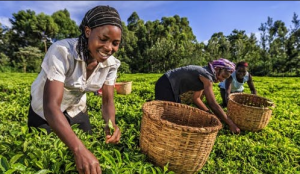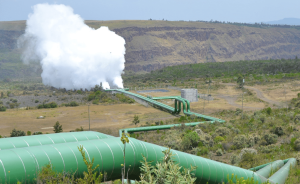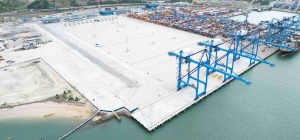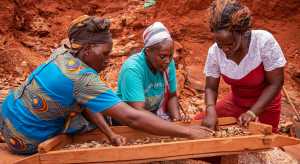The East African Community (EAC) is emerging as one of the most attractive and lucrative regions for investment in Africa. The community, which comprises Kenya, Uganda, Tanzania, Rwanda, Burundi, Somalia, the Democratic Republic of Congo, and South Sudan, is home to a combined market of over 300 million people, with a land area of 5.4 million square kilometres and a combined Gross Domestic Product of US$ 312.9 billion. The EAC continues to position itself as a critical hub for investment as the eight countries are characterized by rapidly developing economies, a growing middle class, expanding infrastructure, and strategic access to global markets. With vast arable land, growing energy demands, ambitious infrastructure projects, rich mineral deposits, and a booming tech scene, the region presents unique opportunities for those looking to diversify their portfolios. Additionally, these countries have favourable policies, regional integration efforts, and a youthful, skilled labour force, thus positioning EAC as a future economic powerhouse.
Let’s look into sectors that are drawing the attention of global investors and how you can capitalize on the wealth of opportunities this thriving region has to offer.
History of the East African Community
Initially formed in 1967 by Kenya, Uganda, and Tanzania, the EAC was envisioned as a regional bloc to promote economic cooperation and integration. However, the first iteration of the EAC ended up dissolved in 1977 due to political differences and economic challenges. The EAC was late revived in 2000, with the same founding members renewing their commitment to regional cooperation. Over time, the community expanded to include Rwanda and Burundi in 2007, South Sudan in 2016, the Democratic Republic of the Congo in 2022, and the Federal Republic of Somalia in 2023, bringing the total number of member states to eight.
The formation of the EAC has significantly enhanced the region’s appeal to foreign investors. Today, the community stands as one of Africa’s most successful regional economic blocs, with a combined population of 312 million people and a rapidly growing GDP. The EAC is currently working towards a full economic and monetary union and has, over time, developed robust trade frameworks, allowing the free movement of goods, services, capital, and labour within member states, bolstering regional trade and investment.
Today, the integration of economies, harmonization of trade policies, simplification of cross-border regulations, and the creation of a larger, unified market, have enabled investors to operate across multiple countries with reduced barriers, and this is all thanks to the EAC.
Overview of partner states in the East African Community
Member States and Population:
- Kenya – 58 million
- Tanzania – 67 million
- Uganda – 49 million
- Rwanda – 13 million
- Burundi – 13 million
- South Sudan – 13 million
- Democratic Republic of Congo (DRC) – 115 million (Joined in 2022)
Total Population: ~343 million
Gross Domestic Product (GDP):
- Kenya: $110 billion
- Tanzania: $70 billion
- Uganda: $40 billion
- Rwanda: $12.4 billion
- Burundi: $3.6 billion
- South Sudan: $5.1 billion
- DRC: $54.8 billion
Total Regional GDP: ~$296 billion
Top 10 Exports (EAC Region)
- Tea (Kenya, Uganda, Rwanda)
- Coffee (Uganda, Tanzania, Burundi)
- Horticultural Products (Kenya)
- Fish and Seafood (Tanzania, Uganda)
- Minerals (Gold, Tin, Tungsten, Tantalum – Tanzania, DRC, Uganda)
- Crude Oil (South Sudan)
- Livestock and Leather Products (Kenya, Tanzania)
- Cotton (Burundi, Uganda, Tanzania)
- Sugar (Kenya, Uganda)
- Cement (Tanzania, Kenya)
Top Investment Opportunities in EAC
1. Agribusiness

Agriculture is the backbone of most EAC economies, contributing significantly to GDP and employing around 70% of the population. This key sector presents one of the most lucrative investment opportunities in the East African Community (EAC), particularly in crop production, processing, and value addition. The region is home to vast tracts of arable land, favourable climates, and a strong tradition of agricultural excellence. Key crops such as tea, coffee, livestock and leather products, and horticultural produce (fruits, vegetables, and flowers) are central to the region’s exports, with EAC countries like Kenya, Uganda, and Tanzania being global leaders in these commodities. Kenya alone exported over 500 million kilograms of tea in 2022.
However, despite the high output of raw agricultural products, the potential for value-added processing remains largely untapped, creating significant opportunities for investors. The region’s growing horticulture sector, known for producing high-quality fruits, vegetables, and cut flowers, holds immense potential for value-added processing. Therefore, investment in cold storage, packaging, and processing facilities could reduce post-harvest losses and improve the shelf life of perishable goods, allowing producers to target export markets more effectively. With growing global demand for organic and processed food products, investors have an opportunity to develop key products, such as fruit juices, canned vegetables, dried fruits, and other processed goods that cater to international consumers.
2. Renewable Energy

Renewable energy is a rapidly growing investment opportunity in the East African Community (EAC), driven by the region’s abundant natural resources and increasing demand for sustainable energy solutions. EAC countries continue to experience rapid economic growth and population expansion, and this has resulted in an increasing need for reliable, affordable, and clean energy. Additionally, governments across the region are enacting favourable policies and incentives, such as tax exemptions and feed-in tariffs, to attract investments in the renewable energy sector.
Wind and geothermal energy present significant opportunities in the EAC. Kenya, for instance, is currently the largest geothermal power producer in Africa, and this can be attributed to its location along the Rift Valley, where the needed geothermal resources can be accessed. As a result, investment in geothermal power plants has proven highly profitable, with the potential to expand into neighboring countries like Uganda and Tanzania. Additionally, wind energy, particularly in regions with strong wind currents like northern Kenya, is another growing sector, with large wind farms already operational and more projects currently underway.
3. Infrastructure

EAC countries are focusing heavily on upgrading and expanding infrastructure to improve connectivity, facilitate trade, and attract foreign investment. Hence, this need for development that touches multiple sectors, including transportation, housing, and telecommunications, offers investors various profitable opportunities. Large-scale projects like the Standard Gauge Railway (SGR) and the expansion of the Port of Mombasa in Kenya are key examples of Public-Private Partnership-related projects undertaken to promote the country’s infrastructure.
The need for development spans multiple sectors, including transportation, energy, housing, and telecommunications, offering foreign investors a wide range of profitable opportunities. Cities across the EAC, including Nairobi, Dar es Salaam, and Kigali, are rapidly expanding, increasing the need for substantial investments in residential, commercial, and industrial real estate. Government programs aimed at addressing housing shortages, such as Kenya’s Affordable Housing Program, have been playing a role in contributing to the development of sustainable urban infrastructure. Investors willing to tap into these opportunities can expect high returns while playing a key role in driving the region’s long-term development and prosperity.
4. Mining and Minerals

The region’s rich deposits of valuable minerals have made the mining and minerals sector a rapidly expanding investment opportunity in the EAC. Countries in the EAC, including Kenya, Tanzania, Uganda, and Rwanda, offer a wide variety of minerals such as gold, diamonds, copper, cobalt, tanzanite, and rare earth elements. Kenya is emerging as a hub for the extraction of rare earth minerals, titanium, and industrial minerals such as limestone and gypsum. Uganda is also known for its deposits of copper, cobalt, and gold. Recent exploration activities in country have also revealed promising opportunities for oil and natural gas extraction. Tanzania is also noteworthy for its mining sector, being one of Africa’s largest producers of gold and also holding substantial reserves of gemstones, particularly tanzanite, a rare gemstone found only in the foothills of Mount Kilimanjaro. Hence, the mining and minerals sector in the EAC offers vast opportunities for investors, from large-scale extraction to value-added processing and ethical mining initiatives.
5. Technology and Innovation

The EAC is rapidly embracing digital transformation and technological advancements, resulting in numerous investment opportunities in the region’s technology and innovation sector. Increasing internet penetration, a youthful and tech-savvy population, and a growing number of tech hubs and innovation ecosystems have made the EAC a hotbed for technological innovation. One of the most prominent areas for investment is fintech, particularly mobile money services. Kenya is globally recognized as the pioneer of mobile banking through platforms such as M-Pesa, which has transformed how people conduct financial transactions. The success of mobile money in the EAC has created a unique opportunity for further innovation in financial technology, with opportunities in mobile payments, lending platforms, digital wallets, and blockchain solutions. Fintech startups are flourishing across the region, providing investors with opportunities to back disruptive technologies that solve financial inclusion challenges and offer scalable solutions across the continent. In addition, software development and digital services represent a high-growth investment sector as the demand for locally developed solutions tailored to the region’s needs is increasing. This has resulted in rising interest in areas such as e-commerce, health tech, agri-tech, and education technology (ed-tech), providing opportunities for investors to fund startups or establish tech-focused companies.
References:
African Union, (n.d.). East African Community (EAC). Retrieved from: https://au.int/en/recs/eac
East African Community. (n.d.). EAC Investment Sectors. Retrieved from: https://www.eac.int/investment-opportunities/eac-investment-sectors
East African Community. (n.d.). History of the East African Community. Retrieved from https://www.eac.int/
East African Community. (n.d.). Invest in Mining. Retrieved from: https://www.eac.int/security/75-sector/investment-promotion-private-sector-development/176-198-40-investment-in-mining
East African Community (n.d.). Overview of the East African Community. Retrieved from: https://www.eac.int/overview-of-eac
World Bank. (2022). Kenya GDP. Retrieved from https://data.worldbank.org/indicator/NY.GDP.MKTP.CD?locations=KE
World Bank. (2022). Tanzania GDP. Retrieved from https://data.worldbank.org/indicator/NY.GDP.MKTP.CD?locations=TZ
United Nations Conference on Trade and Development (UNCTAD). (2022). DRC Mineral Exports. Retrieved from https://unctad.org/
Kenya National Bureau of Statistics (KNBS). (2022). Tea and Coffee Exports. Retrieved from https://www.knbs.or.ke/


